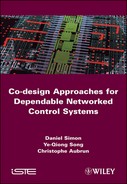Foreword
Modeling, analysis and control of networked control systems (NCS) have recently emerged as topics of significant interest to the control community. The defining feature of any NCS is that information (reference input, plant output, control input) is exchanged using a digital band-limited serial communication channel among control system components (sensors, controller, actuators) and usually shared by other feedback control loops. The insertion of a communication network in the feedback control loop makes the analysis and design of an NCS more challenging. Conventional control theory with many ideal assumptions, such as synchronized control and non-delayed sensing and actuation, must be revisited so that the limitations on communication capabilities within the control design framework can be integrated.
Furthermore, the new trend is to implement the realization of fault diagnosis (FD) and fault tolerant control (FTC) systems that employ supervision functionalities (performance evaluation, fault diagnosis) and reconfiguration mechanisms by using cooperative functions that are also distributed on a networked architecture. A critical issue, therefore, which must always be considered in the design of any networked process control system, is its robustness with respect to failure situations, including system component failures as well as network failures. By network failure, we mean a total breakdown in the communication between the control system components as a result of, for example, some physical malfunction in the networking devices or severe overloading of the network resources that cause a network shut down.
In this framework, dependability of NCS represents the emergence of an important research field. Dependability groups together with three properties that the NCS must satisfy in order to be designed: safety, reliability, and availability. Therefore, the design of a dependable NCSs implies a multidisciplinary approach; more precisely, dealing with a deep knowledge of both fault tolerant control and computer science (mainly real time scheduling and communication protocols).
The content of this book gives an overview of the main results obtained after three years of research work within the safe-NECS project funded by the French “Agence Nationale de la Recherche—ANR”. During these three years, five research groups have cooperated intensively to propose a framework for the design of dependable networked control systems. In this context, the research of safe-NECS took into consid-eration process control functions, FDI/FTC and their implementation over a network as an integrated system. In particular, the project aim was to develop, in a coordinated way, a “co-design” approach that integrates several kinds of parameters: the characteristics modeling the Quality of Control (QoC), the dependability properties required for a system and the parameters of real-time scheduling (tasks and messages). Issues such as network-induced delays, data losses and signal quantization as well as sensor and actuator faults represent some of the more common problems that have motivated the extensive research work developed within the safe-NECS project.
The research work in the safe-NECS project aimed at enhancing the integration of control, real-time scheduling and networking. The safe-NECS project was clearly a multi-disciplinary project in that it brought together partners from the control and computer science communities. A major difficulty for this project came from the fact that both communities manipulate objects and formalisms of very different natures. We consider that one of the major contributions of this project was to promote a synergistic approach, which is a necessary condition for achieving the objectives of the co-design which is demonstrated in this project.
Safe-NECS project focuses on the following points, which are reported in this book:
– specification of a dependable system and performance evaluation;
– modeling the effect of a real-time distributed implementation (i.e. scheduling parameters and networking protocols) on Quality of Control (QoC) and dependability;
– an integrated control and scheduling co-design method realized by developing feedback scheduling algorithms, taking into account both QoC parameters and dependability constraints;
– fault tolerance and the on-line re-configuration of NECS with distributed diagnostic and decision-making mechanisms;
– testing and validation using a UAV-type quadrotor.
Dominique SAUTER
